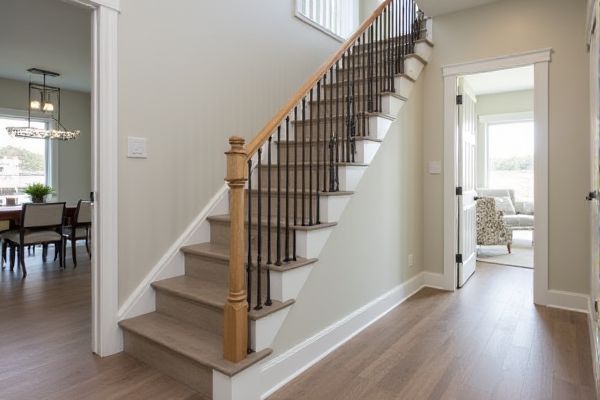
A dual-access staircase offers two entry and exit points, enhancing traffic flow and safety in busy buildings, while a single-access staircase provides only one, which may limit movement and emergency evacuation options. Discover which staircase design best suits your building needs by exploring the detailed comparison in the rest of the article.
Table of Comparison
| Feature | Dual-Access Staircase | Single-Access Staircase |
|---|---|---|
| Access Points | Two separate entry/exit points | One entry/exit point |
| Traffic Flow | Improved flow, reduces congestion | Limited flow, potential bottlenecks |
| Safety | Enhanced emergency evacuation routes | Standard evacuation route |
| Space Requirement | Requires more floor space | More compact footprint |
| Cost | Higher construction and maintenance costs | Lower construction and maintenance costs |
| Common Uses | Commercial buildings, high-traffic zones | Residential buildings, low-traffic areas |
Introduction to Staircase Design
Dual-access staircases offer greater flexibility and improved traffic flow compared to single-access staircases by providing entry and exit points on opposite ends. Your building's design benefits from enhanced safety and convenience, especially in emergency situations where alternate egress routes are crucial. Optimal staircase design considers factors such as available space, user volume, and regulatory compliance to ensure effective movement and accessibility.
Defining Dual-Access and Single-Access Staircases
Dual-access staircases feature two entry points allowing traffic from multiple directions, enhancing flow and accessibility in busy buildings. Single-access staircases have only one entry, suited for simpler layouts or limited space. The dual-access design improves safety during evacuations by providing alternative escape routes, whereas single-access remains cost-effective for less demanding environments.
Space Efficiency Comparison
Dual-access staircases optimize space by allowing entry and exit from two opposite points, reducing the need for larger landings or additional corridors compared to single-access staircases that only connect from one direction. This design enhances traffic flow in confined areas, making it ideal for buildings with high foot traffic or limited floor space. Your choice between dual-access and single-access staircases should consider the balance between spatial constraints and user convenience.
Aesthetic Considerations
Dual-access staircases offer a striking architectural statement with symmetrical design that enhances visual balance, making them ideal for grand entrances or open floor plans. Single-access staircases provide a cleaner, minimalist aesthetic, blending seamlessly into compact spaces where understated elegance is preferred. Your choice depends on the desired spatial impact and overall interior design harmony.
Safety and Accessibility Factors
Dual-access staircases enhance safety by providing multiple egress points, reducing evacuation time during emergencies and alleviating congestion. Single-access staircases may pose accessibility challenges for individuals with mobility issues due to limited entry and exit options, increasing the risk of accidents. Building codes often recommend dual-access designs for high-occupancy structures to improve overall safety and ensure compliance with accessibility standards.
Cost Implications
Dual-access staircases typically involve higher construction and maintenance costs due to increased materials, structural complexity, and safety compliance requirements compared to single-access staircases. The additional access points in dual-access designs can lead to greater labor expenses and more extensive architectural planning, impacting overall project budgets. Single-access staircases offer cost efficiency, making them ideal for projects with budget constraints or simpler spatial layouts.
Flexibility in Architectural Layouts
Dual-access staircases provide greater flexibility in architectural layouts by allowing entry and exit points on multiple floors or directions, facilitating smoother traffic flow in complex building designs. Single-access staircases typically offer a straightforward, linear path, which may limit movement options but can simplify navigation in smaller or more traditional spaces. Your choice between the two should consider how dynamic and accessible you want the circulation within your architectural plan to be.
Usage Scenarios and Best Applications
Dual-access staircases offer efficient traffic flow in high-occupancy buildings such as commercial complexes and emergency exits, allowing simultaneous movement in both directions. Single-access staircases are ideal for smaller spaces or residential settings where limited foot traffic requires straightforward, cost-effective design. Your choice depends on the building's occupancy load and spatial constraints, optimizing safety and convenience.
Maintenance and Durability
Dual-access staircases typically require more frequent maintenance due to increased wear from higher foot traffic and potential mechanical components if automated. Single-access staircases often offer enhanced durability with fewer entry points reducing structural stress and minimizing repair needs. Your choice impacts long-term upkeep costs, making single-access staircases a more maintenance-efficient option for durability and lifespan.
Choosing the Right Staircase Type for Your Project
Choosing the right staircase type depends on available space and traffic flow needs; dual-access staircases enhance accessibility and emergency egress by providing entry points from two directions, ideal for commercial buildings and high-traffic areas. Single-access staircases are more space-efficient and cost-effective, making them suitable for residential projects or areas with limited foot traffic. Evaluating project requirements, including building codes and user convenience, ensures optimal functionality and safety.
 homyna.com
homyna.com